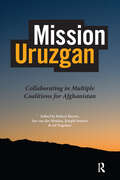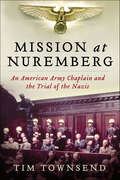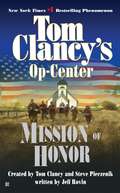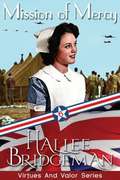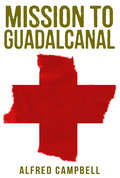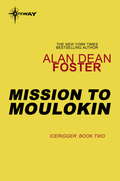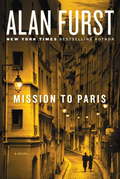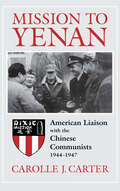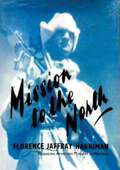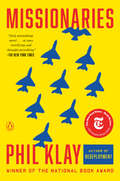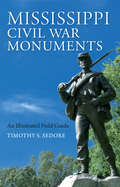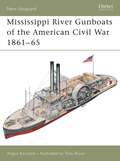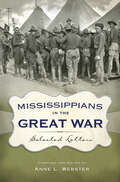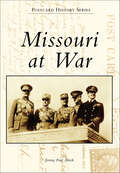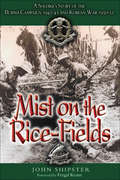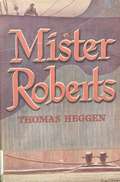- Table View
- List View
Mission Gamma: Twilight (Star Trek: Deep Space Nine #1)
by David R. George IIITHE TIME HAS COME...for a new era of exploration. With the Dominion War behind them, the crew of the U.S.S. Defiant journeys through the wormhole as Commander Elias Vaughn leads a "corps of discovery" to blaze new trails into the unexplored reaches of the Gamma Quadrant. THE TIME HAS COME ...for a civilization to reach a crossroads. As political forces throughout the Alpha Quadrant intersect at Deep Space 9 to determine the future of Bajor, the planet's theological unity threatens to shatter. And for Colonel Kira Nerys, the path of the Prophets may become a road to ruin. THE TIME HAS COME...for a father and daughter to confront their past while a mother and son fight for the future, for lovers to be tested and for friendships to transform, and for worlds on opposite ends of the galaxy to face the dusk...or the dawn. TWILIGHT
Mission Revolution: The U.S. Military and Stability Operations (Columbia Studies in Terrorism and Irregular Warfare)
by Jennifer TawDefined as operations other than war, stability operations can include peacekeeping activities, population control, and counternarcotics efforts, and for the entire history of the United States military, they have been considered a dangerous distraction if not an outright drain on combat resources. Yet in 2005, the U.S. Department of Defense reversed its stance on these practices, a dramatic shift in the mission of the armed forces and their role in foreign and domestic affairs. With the elevation of stability operations, the job of the American armed forces is no longer just to win battles but to create a controlled, nonviolent space for political negotiations and accord. Yet rather than produce revolutionary outcomes, stability operations have resulted in a large-scale mission creep with harmful practical and strategic consequences. Jennifer Morrison Taw examines the military's sudden embrace of stability operations and its implications for American foreign policy and war. Through a detailed examination of deployments in Iraq and Afghanistan, changes in U.S. military doctrine, adaptations in force preparation, and the political dynamics behind this new stance, Taw connects the preference for stability operations to the far-reaching, overly ambitious American preoccupation with managing international stability. She also shows how domestic politics have reduced civilian agencies' capabilities while fostering an unhealthy overreliance on the military. Introducing new concepts such as securitized instability and institutional privileging, Taw builds a framework for understanding and analyzing the expansion of the American armed forces' responsibilities in an ever-changing security landscape.
Mission Transition: Navigating the Opportunities and Obstacles to Your Post-Military Career
by Matthew J. LouisMission Transition is an essential career-change guide for any transitioning veteran that wants to avoid false starts and make optimal career choices following active duty.Every year, about a quarter of a million veterans leave the military - most of whom are unprepared for the transition. These service members have developed incredible leadership, problem-solving, and practical skills that are underutilized once they reach the civilian world, a detriment to both themselves and society.Well-intentioned Transition Assistance Programs and other support structures within the armed forces often leave veterans fending for themselves. The mission-first culture of the military results in service members focusing on their active duty roles in the year leading up to their separation, leaving them little time to adequately prepare to join the civilian world.President of Purepost, a next-generation staffing solution and public benefits corporation, and author Matthew J. Louis guides military personnel through the entire process of making a successful move into civilian professional life.In Mission Transition, this book will:Guide you through the process of discovering what path you want to take going forwardTeach you the strategies that will make your résumé stand outProvide suggestions to help you prepare for and ace the interviewDiscuss ways to acclimate to your new organization&’s culture and pay it forward to other veteransEach chapter includes advice from other veterans, illustrations of key concepts, summaries, and suggested resources. Let this well-written and easy to follow guidebook help you transition out from the military and commit to being successful in the next chapter of your life.
Mission Uruzgan: Collaborating in Multiple Coalitions for Afghanistan
by Joseph Soeters Robert Beeres Jose Vetten Jan MeulenAn on-site testimony of the Dutch military mission in Urugzan, Afghanistan from 2001 to present day.Presents fresh data and probing analyses to address many crucial issues with regard to mission Uruzgan: from political decision making to rules of engagement.Offers insight regarding the logistics of leadership at many different levels in Afghanistan.From autumn 2001 onwards, the Netherlands armed forces have been involved in military operations in Afghanistan. These deployments found their culmination in a four-year period (2006-2010) when the Netherlands acted as lead-nation in the province of Uruzgan. This book provides a wealth of insights into the many problems the Dutch military had to cope with. Focusing on the collaborative aspect, the authors trace the principles and practices of working together with partners in multiple military coalitions, involving the local population and its variety of power brokers, allies in and beyond NATO, and civil and military entrepreneurs.
Mission at Nuremberg: An American Army Chaplain and the Trial of the Nazis
by Tim Townsend“Just when you think there could be nothing new to say about the Nazis, here’s a unique account that raises pressing moral and spiritual issues.” —Library JournalLutheran minister Henry Gerecke was fifty years old when he enlisted as an Army chaplain during World War II. As two of his three sons faced danger and death on the battlefield, Gerecke tended to the battered bodies and souls of wounded and dying GIs outside London. At the war’s end, when other soldiers were coming home, Gerecke was recruited for the most difficult engagement of his life: ministering to the twenty-one Nazis leaders awaiting trial at Nuremburg.Based on scrupulous research and first-hand accounts, including interviews with still-living participants and featuring sixteen pages of black-and-white photos, Mission at Nuremberg takes us inside the Nuremburg Palace of Justice, into the cells of the accused and the courtroom where they faced their crimes. As the drama leading to the court’s final judgments unfolds, Tim Townsend brings to life the developing relationship between Gerecke and Hermann Goering, Albert Speer, Wilhelm Keitel, Joachim von Ribbentrop, and other imprisoned Nazis as they awaited trial.Powerful and harrowing, Mission at Nuremberg offers a fresh look at one most horrifying times in human history, probing difficult spiritual and ethical issues that continue to hold meaning, forcing us to confront the ultimate moral question: Are some men so evil they are beyond redemption?“A gripping story . . . puts the reader inside the cells of various Hitler henchmen.” —The Wichita Eagle“Townsend authoritatively addresses the excruciating moral and religious issues confronting wartime chaplains . . . rich, potentially explosive.” —Kirkus Reviews
Mission of Honor (Tom Clancy's Op-Center #9)
by Tom Clancy Steve PieczenikWhen a priest is kidnapped by African militiamen who demand all Catholic missionaries leave Botswana, the Vatican urges Op-Center to investigate. The real purpose of the crime is revealed to be a plan to destabilize the government and seize the nation's diamond mines. With Striker out of commission, Op-Center must reinvent itself and heads into the crossfire of an African war.
Mission of Mercy, a Novella: Virtues and Valor #6
by Hallee Bridgeman[Doctor BETTY GRIMES, miraculously survives the Nazi bombing of her hospital but suffers the loss of her fiancé in the raid. She goes to the countryside to grieve and recuperate and there meets the leader of the Virtues team who recruits the brilliant surgeon. After months of training, Betty, code-named MERCY, now works in Occupied France as a nurse, where she garners information from patients and passes it to the Allies. Secretly, she tends to injured Resistance operatives, treating gunshots and other wounds that would otherwise draw the attention of the Third Reich. When Betty is sent to the local prison to see to a prisoner who has taken ill, her shock at finding TEMPERANCE nearly blows her cover. Now Temperance is sick and Mercy needs to get her well enough for the coming rescue operation to succeed. Can MERCY save TEMPERANCE in time for her rescue, or will her patient succumb to the disease brought on by the torture of the Gestapo? MISSION OF MERCY is part six of seven serialized novellas entitled the Virtues and Valor series.
Mission to Guadalcanal
by Alfred CampbellMission to Guadalcanal, first published in 1945 as Guadalcanal Round-Trip, is the World War Two account of Red Cross Field Director Alfred Campbell aboard the cruiser U.S.S. Astoria, and on land on Guadalcanal and the Solomon Islands. Before his departure from the U.S., Campbell stocked up on essential supplies such as first-aid kits, extra clothing, etc., as well as on morale-building supplies for the marines about to go into combat, including playing cards, board games, boxing gloves, cigarettes, and fishing equipment, Campbell's dedication to the troops is apparent throughout the book and the marines frequently turned to him for advice and guidance while aboard the ship. Included is a Foreword by noted war correspondent Richard Tragaskis.
Mission to Moulokin (Gateway Essentials #524)
by Alan Dean FosterFor Ethan Frome Fortune and his musclebound sidekick Skua September, the frozen planet of Tran-ky-ky had become too much of a cold thing. Aboard their giant icerigger Slanderscree, they headed for the trading post of Brass Monkey to book a passage home. Then fate intervened with the news that their Tran friends were being exploited by ruthless off-world profiteers. To help, Ethan and Skua - interplanetary sales team extraordinaire - must make a desperate mission to Moulokin, the fabled fortified city across the frozen seas and ringed with chilling peril...
Mission to Paris: A Novel (Night Soldiers #12)
by Alan FurstIt is the late summer of 1938, Europe is about to explode, the Hollywood film star Fredric Stahl is on his way to Paris to make a movie for Paramount France. The Nazis know he's coming--a secret bureau within the Reich Foreign Ministry has for years been waging political warfare against France, using bribery, intimidation, and corrupt newspapers to weaken French morale and degrade France's will to defend herself. For their purposes, Fredric Stahl is a perfect agent of influence, and they attack him. What they don't know is that Stahl, horrified by the Nazi war on Jews and intellectuals, has become part of an informal spy service being run out of the American embassy in Paris. From Alan Furst, the bestselling author, often praised as the best spy novelist ever, comes a novel that's truly hard to put down. Mission to Paris includes beautifully drawn scenes of romance and intimacy, and the novel is alive with extraordinary characters: the German Baroness von Reschke, a famous hostess deeply involved in Nazi clandestine operations; the assassins Herbert and Lothar; the Russian film actress and spy Olga Orlova; the Hungarian diplomat and spy, Count Janos Polanyi; along with the French cast of Stahl's movie, German film producers, and the magnetic women in Stahl's life, the socialite Kiki de Saint-Ange and the émigré Renate Steiner. But always at the center of the novel is the city of Paris, the heart and soul of Europe--its alleys and bistros, hotels grand and anonymous, and the Parisians, living every night as though it was their last. As always, Alan Furst brings to life both a dark time in history and the passion of the human hearts that fought to survive it.Advance praise for Mission to Paris "The writing in Mission to Paris, sentence after sentence, page after page, is dazzling. If you are a John le Carré fan, this is definitely a novel for you."--James Patterson "I am a huge fan of Alan Furst. Furst is the best in the business--the most talented espionage novelist of our generation."--Vince Flynn Praise for Alan Furst "Unfolds like a vivid dream . . . One couldn't ask for a more engrossing novel."--The Wall Street Journal, about Spies of the Balkans "Though set in a specific place and time, Furst's books are like Chopin's nocturnes: timeless, transcendent, universal. One does not so much read them as fall under their spell."--Los Angeles Times, about The Spies of Warsaw "Alan Furst's novels swing a beam into the shadows at the edges of the great events leading to World War II. Readers come knowing he'll deliver effortless narrative."--USA Today, about The Foreign Correspondent "Positively bristles with plot, characters and atmosphere . . . Dark Voyage has the ingredients of several genres--the mystery, the historical novel, the espionage thriller, the romance--but it rises above all of them."--The Washington Post, about Dark Voyage "No other espionage writer touches [Furst's] stylish forays into Budapest and Berlin, Moscow and Paris. No other writer today captures so well the terror and absurdity of the spy, the shabby tension and ennui of émigré communities at the time. His characters are hopeless, lethal, charming. His voice is, above all, knowing."--Boston Sunday Globe, about Blood of VictoryFrom the Hardcover edition.
Mission to Yenan: American Liaison with the Chinese Communists, 1944–1947
by Carolle J. CarterA deep dive into the Dixie Mission. “Aficionados of American political and diplomatic history may be pleasantly surprised at the riches in this book.” —American Historical ReviewConventional wisdom informs us that “only Nixon could go to China.” In fact, in 1944, nearly thirty years before his historic trip, the American military established the first liaison and intelligence-gathering mission with the Chinese Communists in Yenan. Commonly referred to as the Dixie Mission, the detached military unit sent to Yenan was responsible for transmitting weather information, assisting the Communists in their rescue of downed American flyers, and laying the groundwork for an eventual rapprochement between the Communists and Nationalists, the two sides struggling in the ongoing Chinese Civil War.Following extensive use of archival sources and numerous interviews with the men who traveled and served in Yenan, Carolle Carter argues that while Dixie fulfilled its assignment, the members steered the mission in different directions from its original, albeit loosely described, intent. As the months and years passed, the Dixie Mission increasingly emphasized intelligence gathering over evaluating their Communist hosts’ contribution to the war effort against Japan.Some American politicians in the 1950s portrayed the participants in the Dixie Mission as too sympathetic to the Chinese Communists. But during the 1970s many looked back at these individuals as wise but ignored oracles who could have prevented the “loss of China.” Carter strips away these simplistic portrayals to reveal a diverse and dedicated collection of soldiers, diplomats, and technicians who had ongoing contact with the Chinese Communists longer than any other group during World War II, but who were destined to be a largely unused resource during the Cold War.
Mission to the North
by Florence Jaffray HarrimanMission to the North by Florence Jaffray Harriman is an engaging and insightful memoir that chronicles the extraordinary experiences of a pioneering American diplomat during a critical period in world history. As one of the first women to serve as a U.S. ambassador, Harriman provides a unique perspective on the challenges and triumphs she encountered while serving as the U.S. Minister to Norway during the tumultuous years of World War II.Harriman’s memoir vividly recounts her diplomatic mission to Norway, a country caught in the grip of Nazi occupation. With courage and determination, she navigated the complexities of international relations, working tirelessly to protect American interests and support the Norwegian resistance. Her narrative is filled with gripping accounts of wartime diplomacy, including the evacuation of American citizens, negotiations with German officials, and her interactions with key figures in the Norwegian government-in-exile.Mission to the North is not only a personal memoir but also a testament to the resilience and strength of the human spirit in the face of adversity. Harriman’s writing captures the tension and uncertainty of the era, while also highlighting the courage and solidarity of the Norwegian people during one of the darkest chapters in their history.Throughout the book, Harriman reflects on the broader implications of her work, offering insights into the role of diplomacy, the challenges faced by women in positions of power, and the importance of perseverance in the pursuit of justice and peace. Her story is both inspiring and informative, providing readers with a deeper understanding of the complexities of international relations during a time of global conflict.Mission to the North is an essential read for anyone interested in history, diplomacy, and the contributions of women to the shaping of modern world events. Florence Jaffray Harriman’s memoir is a powerful reminder of the impact that one individual can have on the course of history, and it stands as a lasting tribute to her legacy as a trailblazing diplomat and advocate for peace.
Mission: A Battle-Tested Guide to an Enduring Relationship
by Jason Redman Erica RedmanFrom Jason Redman, the former Navy SEAL and New York Times bestselling author of The Trident, writing with his wife, Erica, a battle-tested guide to marital bliss, drawing on the lessons of elite warriors to build a winning relationship, no matter the challenges and traumas that life sends your way. Featuring a foreword by Gary Sinise.The divorce rate among Navy SEALs is over 90 percent, and the rate among severely wounded warriors is even higher. Erica and Jason Redman knew their marriage faced an uphill climb, because Jason is both.In 2007, Jason’s patrol was ambushed by a machine gunners’ nest in Iraq. Thirty-seven surgeries, 1,200 stitches, and a grueling years-long rehab would follow. Despite all that—plus the daily demands of raising three children and running a successful business together—Jason and Erica’s marriage has remained invincible.Every day, you make choices that either build up your relationship or leave it exposed and vulnerable to attack. The highest-performing warrior teams pay attention to developing muscle-memory habits, and your marriage can benefit from the same focus.In Mission: Invincible Marriage, Jason and Erica share the tools they use to lay the foundational beliefs and communication skills a marriage needs to last for life. Each chapter helps readers develop a key tenet of successful relationship-building. Among them:Commit to Friendship: The foundation of all successful marriages is genuine friendshipSupport Each Other’s Dreams: Couples who establish a pattern of supporting each other’s dreams can thrive even when those dreams grow and changeKnow When to Give Space: Learn to trust each other enough to give and take space when needed instead of resorting to passive-aggressive responses and stonewallingEstablish Rituals: Couples can strengthen their marriage by finding ways to invest in small shared actions that reflect and reinforce commitmentFace Conflict Together: Marital strength is not the absence of conflict but the ability to withstand and work through conflictDrawing on their own experiences and the latest research in long-term interpersonal relationships, Mission: Invincible Marriage is a battle-tested guide to nurturing love, especially when the going gets tough.
Mission: Cavanaugh Baby (Cavanaugh Justice #25)
by Marie FerrarellaAn Entertainment Weekly Top 10 Romance AuthorFrom USA TODAY bestselling author Marie Ferrarella comes another Cavanaugh Justice book, and this time a baby's in jeopardy…The only things Ashley St. James has ever allowed herself to love are her dogs. A child of the foster-care system, she never even knew her own birthday. When a dog in distress leads her to a brutally butchered woman whose baby was stolen, Ashley has a purpose—so she teams up with cop Shane Cavanaugh.Losing his fiancée only ripened Shane's thirst for justice. But the closer he gets to Ashley, the more he wants to erase the tears she hasn't managed to dry. If they can find the missing baby and nab a psychotic killer first.If you love this read from Marie Ferrarella, unearth more scintillating secrets of the Adair family in CARRYING HIS SECRET, her 250th Harlequin book! Available only from Harlequin Romantic Suspense!
Mission: Motherhood (Homecoming Heroes #1)
by Marta PerryA small-town Texas Army chaplain helps a high-powered New York attorney adjust to raising her orphaned nieces in this inspirational romance.Overnight, Caitlyn Villard becomes mother to twin five-year-olds. Her darling nieces are orphaned, their parents fallen soldiers. So, Caitlyn trades New York City for Prairie Springs, Texas, the small military town she’d run from at first chance. Loving the girls is easy. Learning how to be a slow-paced soccer mom is not. Which is where handsome Army chaplain Steve Windham steps in. Just in time to show Caitlyn that sometimes you find the man—and life—of your dreams where you least expected.
Missionaries: A Novel
by Phil KlayThe debut novel from the National Book Award-winning author of Redeployment"[This] compact epic of a novel contains perhaps Klay's finest writing yet . . . Using his formidable gifts for scene-setting, meaningful irony and deep human empathy, Klay weaves together a set of stories over the course of nearly three decades . . . Amid raging fires and illness and constitutional crises, Klay's book roars something vital: Never forget about war or the blood and bone and the evil and the reckless idealism of who we all really are." --Los Angeles TimesA group of Colombian soldiers prepares to raid a drug lord's safe house on the Venezuelan border. They're watching him with an American-made drone, about to strike using military tactics taught to them by U.S. soldiers who honed their skills to lethal perfection in Iraq. In Missionaries, Phil Klay examines the globalization of violence through the interlocking stories of four characters and the conflicts that define their lives.For Mason, a U.S. Army Special Forces medic, and Lisette, a foreign correspondent, America's long post-9/11 wars in the Middle East exerted a terrible draw that neither is able to shake. Where can such a person go next? All roads lead to Colombia, where the US has partnered with local government to keep predatory narco gangs at bay. Mason, now a liaison to the Colombian military, is ready for the good war, and Lisette is more than ready to cover it. Juan Pablo, a Colombian officer, must juggle managing the Americans' presence and navigating a viper's nest of factions bidding for power. Meanwhile, Abel, a lieutenant in a local militia, has lost almost everything in the seemingly endless carnage of his home province, where the lines between drug cartels, militias, and the state are semi-permeable. Drawing on six years of research in America and Colombia into the effects of the modern way of war on regular people, Klay has written a novel of extraordinary suspense infused with geopolitical sophistication and storytelling instincts that are second to none. Missionaries is a window not only into modern war, but into the individual lives that go on long after the drones have left the skies.
Mississippi Civil War Monuments: An Illustrated Field Guide
by Timothy S. Sedore“From Vicksburg to Oxford, readers will find a rich examination of how and why Confederate and Union monuments sprang up across the state.” —Caroline E. Janney, Director, John L. Nau III Center for Civil War History, University of VirginiaSoaring obelisks, graceful arches, and soldiers standing tall atop pedestals recall the memory of the Civil War in Mississippi, a former Confederate state that boasts more Civil War monuments than any other.In Mississippi Civil War Monuments: An Illustrated Field Guide, Timothy S. Sedore combs through the Mississippi landscape, exploring monuments commemorating important military figures and battles and remembering common soldiers, from rugged veterans to mournful youths. Sedore’s insightful commentary captures a character portrait of Mississippi, a state that was ensnared between Northern and Southern ideologies and that paid a high price for seceding from the Union. Sedore’s close examinations of these monuments broadens the narrative of Mississippi’s heritage and helps illuminate the impacts of the Civil War.With intriguing details and vivid descriptions, Mississippi Civil War Monuments offers a comprehensive guide to the monuments that make up Mississippi’s physical and historical landscape.
Mississippi Civil War Monuments: An Illustrated Field Guide
by Timothy S. Sedore“From Vicksburg to Oxford, readers will find a rich examination of how and why Confederate and Union monuments sprang up across the state.” —Caroline E. Janney, Director, John L. Nau III Center for Civil War History, University of VirginiaSoaring obelisks, graceful arches, and soldiers standing tall atop pedestals recall the memory of the Civil War in Mississippi, a former Confederate state that boasts more Civil War monuments than any other.In Mississippi Civil War Monuments: An Illustrated Field Guide, Timothy S. Sedore combs through the Mississippi landscape, exploring monuments commemorating important military figures and battles and remembering common soldiers, from rugged veterans to mournful youths. Sedore’s insightful commentary captures a character portrait of Mississippi, a state that was ensnared between Northern and Southern ideologies and that paid a high price for seceding from the Union. Sedore’s close examinations of these monuments broadens the narrative of Mississippi’s heritage and helps illuminate the impacts of the Civil War.With intriguing details and vivid descriptions, Mississippi Civil War Monuments offers a comprehensive guide to the monuments that make up Mississippi’s physical and historical landscape.
Mississippi River Gunboats of the American Civil War 1861-65
by Tony Bryan Angus KonstamAt the start of the American Civil War, neither side had warships on the Mississippi River and in the first few months both sides scrambled to gather a flotilla, converting existing riverboats for naval use. These ships were transformed into powerful naval weapons despite a lack of resources, trained manpower and suitable vessels. The creation of a river fleet was a miracle of ingenuity, improvisation and logistics, particularly for the South. This title describes their design, development and operation throughout the American Civil War.
Mississippians in the Great War: Selected Letters
by Anne L. WebsterEven Mississippi textbooks rarely mention the part Mississippi men and women played in World War I. Mississippians in the Great War presents in their own words the story of Mississippians and their roles. This body of work divides into five sections, each associated with crucial dates of American action. Comments relating to various military actions are interspersed throughout to give the reader a context of the wide variety of experiences. Additionally, where possible, Anne L. Webster provides information on the soldier or sailor to show what became of him after his service. Webster examined newspapers from all corners of the state for “letters home,” most appearing in newspapers from Natchez, Greenville, and Pontotoc. The authors of the letters gathered here are from soldiers, aviators, sailors, and relief workers engaged in the service of their country. Letter writing skills varied from citizens of minimal literacy to those who would later become published authors and journalists. These letters reflect the experiences of green, young Mississippians as they endured training camp, voyaged across the Atlantic to France, and participated in horrific battles leaving some scarred for life. To round out the picture, Webster includes correspondence from nurses and YMCA workers who describe drills, uniforms, parades, and celebrations.
Missouri at War (Postcard History Series)
by Jeremy Paul AmickThe Show-Me State possesses an enduring military heritage that unfolded several decades before it became a state in 1821 and stretches forth to the present day. Missouri has molded many notable military leaders, such as Gen. John J. Pershing, the commander of the American Expeditionary Forces in World War I. It has been the site of a Spanish fort, built in the area that is now downtown St. Louis, and serves as the home of the Liberty Memorial in Kansas City. These people and memorials continue to generate reminders to its citizens of the sacrifices made by the brave men and women who have fought on behalf of the state and nation.
Missouri in World War I (Images of America)
by Jeremy Paul AmickThe state of Missouri played a unique role in World War I--as the birthplace of Gen. John J. Pershing, the commanding officer of the American Expeditionary Forces, and Maj. Gen. Enoch Crowder, the primary author of the military draft--and it is an impressive legacy featuring a colorful cast of characters, events, and communities. Missouri was home to two flying aces of the war as well as Bennett Champ Clark, the youngest colonel in the American Expeditionary Forces and the first national commander of the American Legion. During the war, the state was home to farms and ranches that provided an army of mules that assisted Allied forces in hauling critical materials and equipment in the harshest of conditions. Additionally, 156,000 of the state's citizens served in the military with approximately 10,000 wounded or killed in action.
Mist Over The Mersey: An absolutely engrossing saga of romance, friendship and war
by Lyn AndrewsOnce war strikes, life can never be the same again... A close-knit community is devastated by the outbreak of World War I in heart-breaking saga, Mist over the Mersey - a tale of families, friendship and romance from bestselling author Lyn Andrews. Perfect for fans of Katie Flynn and Maureen Lee.The Chatterton family is far too posh for the Liverpool slums where they've ended up. Nancy Butterworth and Abbie Kerrigan, lifelong residents of the place, tried to befriend Dee Chatterton, but her mother wants her to have nothing to do with such rough children. The Burgess family looks forward to the arrival of their young cousin Sean from Dublin, and Nancy is not the first to lose her heart to the Irish charmer.In 1914 things are to change dramatically, and the families are to find that money and social position mean nothing when the horrors of the First World War invade their lives and take away their sons...Don't miss Lyn Andrews' sequel to the novel, Mersey Blues. What Amazon readers are saying about Mist Over the Mersey: 'This book grabs you from the first word to the last. As soon as I started to read it, I could see all the characters so clearly, as if I were there with them. It only took me two days to read it, as I could not put it down''Lyn Andrews is definitely an author you want to discover time and again. She writes with real clarity, wit and warmth...The characters that Lyn Andrews has written about are people that you feel are truly real'
Mist on the Rice-Fields: A Soldier's Story of the Burma Campaign 1943–1045 and Korean War 1950–51
by John ShipsterThis is the story of a young officer in the Indian Army who commanded a company in the Burma Campaign of 1943 to 1945. It covers the part played by the author and his unit in the long campaign to recover Burma, starting with the fierce close-quarter fighting in the jungles and rice-fields in the Arakan in which the Japanese suffered their first major defeat. The story moves on to Kohima which was the scene of some of the bitterest fighting in the Burma War, and which saved India. For the author, however, the Burma War was a prelude to the bitter campaign in Korea (1950-51), where the author commanded a company of the Middlesex Regiment in the harsh conditions of extreme cold and snow, as part of the Commonwealth Brigade fighting in close co-operation with the Americans.
Mister Roberts (Classics Of Naval Literature Ser.)
by Thomas HeggenThe novel, Mister Roberts, was an instant hit after being published in 1946 and was quickly adapted for the stage and screen. The title character, a Lieutenant Junior Grade naval officer, defends his crew against the petty tyranny of the ship's commanding officer during World War II. Nearly all action takes place on a backwater cargo ship, the USS Reluctant, that sails, as written in the play, "from apathy to tedium with occasional side trips to monotony and ennui." This irreverent, often hilarious story about the crew of the Reluctant has enjoyed wide and enduring popularity. Heggen based his novel on his experiences aboard the USS Virgo in the South Pacific during World War II, and began as a collection of short stories. It was subsequently adapted as a play, a feature film, a television series, and a television movie. The film version with Henry Fonda, James Cagney and Jack Lemmon is one of the most well-known movies of WWII.-Print ed."This book is vivid, unimpeachable narrative, with no holds barred. But elders with a distaste for the frankness of the sea and profanity should keep out."--ATLANTIC MONTHLY"The remarkable thing is that such an honest, behind-the-scenes portrayal of the Navy as it usually is--in dungarees rather than dress blues--has never been attempted."--BOOK WEEK"Mr. Heggen has written a little classic. It invites reading aloud; it stirs vivid memories."--THE NEW YORK TIMES



